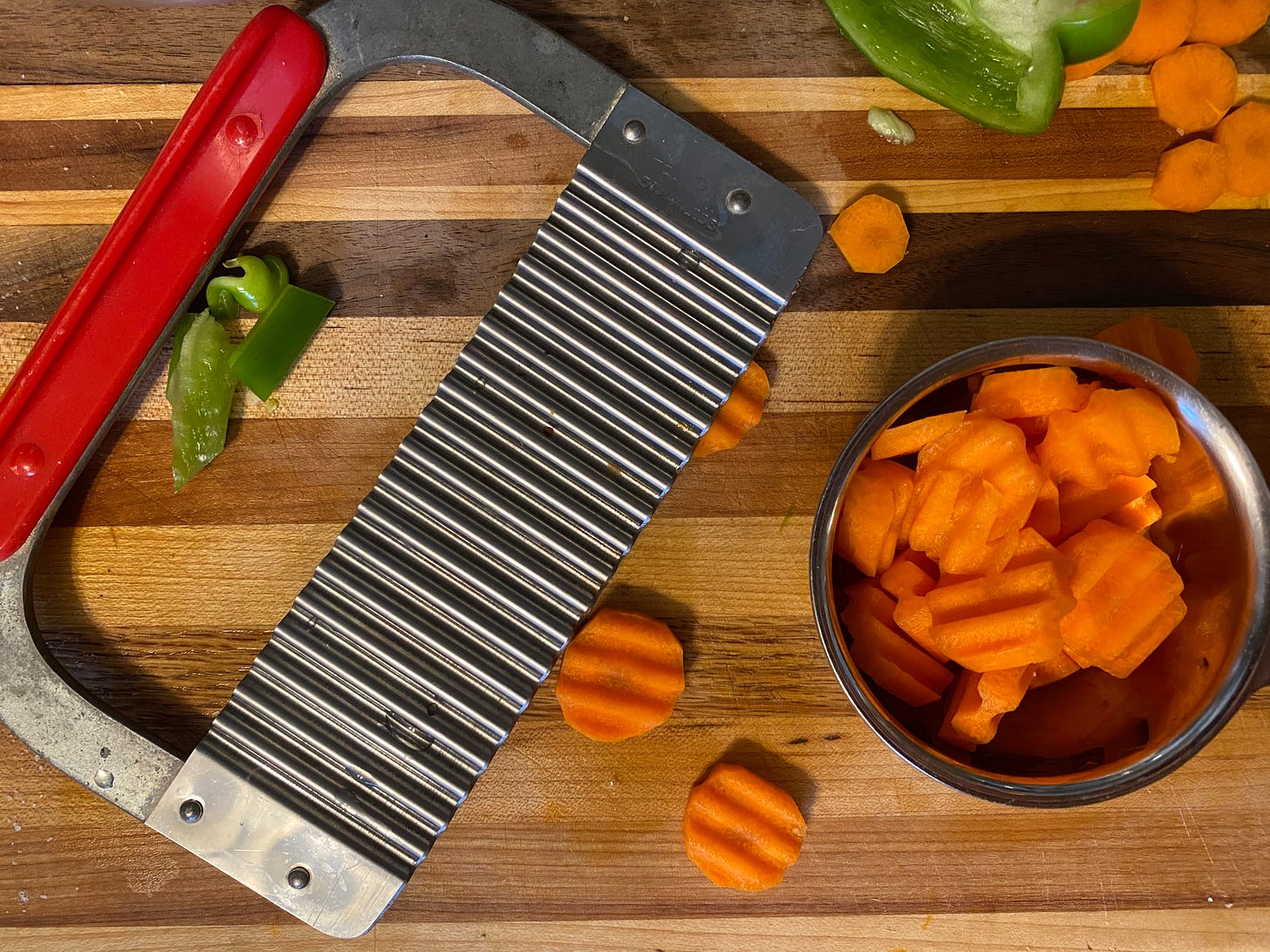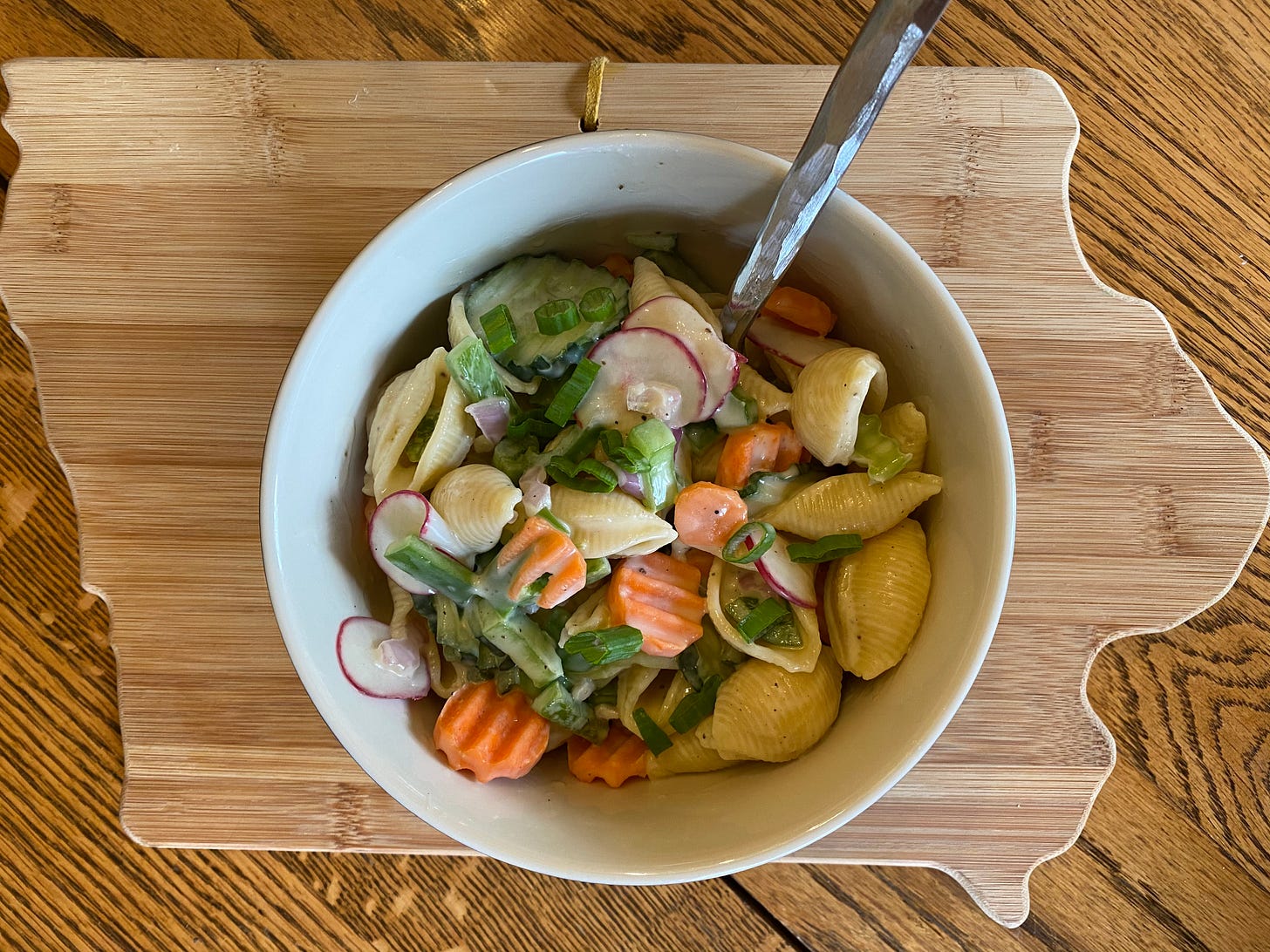I was 31 years old before I realized that not everyone has the same conception of “spring salad.” I grew up eating it after Sunday mass at the only brunch spot in my hometown: the Hy-Vee deli. Until this year, I had assumed it was a common dish with known parameters, like beef Wellington or pad see ew. I thought everyone knew “spring salad” meant a bowl of cold pasta coated in sweet mayonnaise.
Turns out, I’d been bewitched by the branded invention of a supermarket deli.
Hy-Vee is a mid-tier grocery chain founded in Iowa. The name is a portmanteau of “Hyena” and “Vehicle.” The Hy-Vee in my hometown was unremarkable except for the deli case, which was a gleaming snowglobe of dairy-based salads. Everything in it was a shade of white: potato salad, Waldorf salad, Oreo fluff speckled like a sparrow’s egg. Even the broccoli florets were stippled with mayonnaise. If you squinted closely, you could just make out a ghostly pistachio hue on the Watergate salad, plumped with mini marshmallows.
In the deli case, lettuce was only ever a garnish: a shock of green against dewy melamine bowls. In one of those bowls, my childhood obsession: chubby pasta shells, ridged for her pleasure, swimming in a pool of creamy dressing. There were pops of spring colors—crinkly slices of carrots and cucumbers, wisps of radish, interjections of green pepper—but everything was blunted with a milky sheen.
Never mind that cucumbers and green peppers are summer vegetables. To this day, I cannot hear Vivaldi’s “The Four Seasons” without picturing enormous conchiglie falling from the heavens like a soft spring rain.
If you live near a Hy-Vee, you can buy pre-packaged spring salad in stocky plastic quart containers. You can also buy it from the deli case. The packaged version doesn’t have radishes, but the deli version does. I cannot explain this discrepancy. Hy-Vee has their reasons, and they are sinister.
But you can also make it at home in about 20 minutes:
8 ounces medium or large shell pasta, cooked al dente (not super soft) and cooled1
1/2 cup each thin-sliced radish, carrot, English cucumber, and green bell pepper
1 small shallot, minced
1/2 cup mayonnaise
1 tablespoon granulated sugar
1/2 tablespoon white vinegar
Kosher salt to taste
If you have a crinkle cutter, I highly recommend using it on the veggies. This salad can only benefit from its kitschy lunch counter vibes. I used a 50-year-old crinkle cutter that resembles a funhouse guillotine.
Because I am obstinate, I used it on everything, including the shallot. I should note here that it’s a Bad Idea (in an objective, chef-y sense) to crinkle cut a shallot—you’ll crush those cell walls like a yard beer in June, maximizing the shallot’s sulfuric sharpness. But I sometimes think Food People spend so much time focusing on marginal benefits to technique, they overlook the other ways food and cooking can bring pleasure.2
For example, crinkle cutting.
Literary agents, I am currently seeking representation for Crinkle Cut Everything: A Memoir.
In a separate bowl, whisk together the mayonnaise, sugar, and vinegar with a pinch of kosher salt. If you can get your hands on Kewpie mayo, it’s ideal here. Kewpie is made with MSG and both rice and red wine vinegar, giving the dressing a more interesting acid profile. Plus, everything’s better with MSG.
Combine the pasta with the raw vegetables and dressing until you have a conflict of textures. You should feel confused by this salad, much as you do by the wet ground squelching under your feet on a clear and sunny April afternoon.
If the idea of sugar in your pasta salad is repulsive to you—well, I get it. But this salad is sweet in the way that a McDonald’s hamburger bun is sweet. The sugar is there for purely chemical reasons, to manipulate your dopamine receptors like a four-chord pop song. If pleasure is a piano, sugar is Middle C.
There’s a tendency to denigrate sugary, mayonnaise-slicked salads as “bland white people food,” a sentiment that’s as fashionable as it is inaccurate. Macaroni salad was a staple of the Hawaiian plate lunch favored by the East Asian, Portuguese, and Filipino immigrants working on pineapple and sugar plantations. Pasta salad is a party dish in Puerto Rico; it’s also a frequent flyer at Black cookouts in the American South.
Granted, this particular “spring salad” is a Midwestern invention, and I’m not going to argue its ubiquity. Just look at the Hy-Vee deli case. But I will argue this point: there’s nothing bland about the cold, blunted brilliance of mayonnaise-dressed salads. Mayonnaise is delicious. It compounds acid and richness in a chemically elegant way. It makes food more luxurious regardless of the other flavors at play. It’s fantastic on French fries. What’s not to like? (Fellas, is it bland to emulsify fats?)
I’ve written before about my affection for the unfashionable food of the Midwest. I think it’s overlooked as a regional cuisine in part because many of its signifiers are embraced only by home cooks. But mayonnaise is a slathery standard bearer we should embrace instead of feign embarrassment about.
Hy-Vee periodically mails out a magazine geared at cooks and wreath makers called Seasons. Thus far, they’ve lacked the courage to dedicate an entire Season to the refrigerated deli case—to the pasta aquarium. I’ll do it for them. I’m still bewitched by those condensation-beaded bowls, by the chimerical alchemy of calcium + carbs. It’s Spring Salad Season (Motherfuckers).
Haterade is a labor(?) of love(?). If you’d like to reinforce my increasingly deranged opinions, share, subscribe, or send the newsletter to your most feral friend. You can also stuff some money in the tip jar: @lizcookkc on Venmo. If you have topic suggestions or just want me to write more/less, drop me a line: lizcook.kc@gmail.com
Food People will tell you to rinse your pasta after draining when you make pasta salad, but I never do. The Pasta Rinsing Logic seems questionable. If starch from the cooking water aids sauce adherence on hot pasta, it ought to do the same for cold.
I think this is why I never really connected with the work of Alton Brown. I love his food-science explainers, but the man would have you construct a terracotta particle collider in your backyard just to barbecue a chicken.






